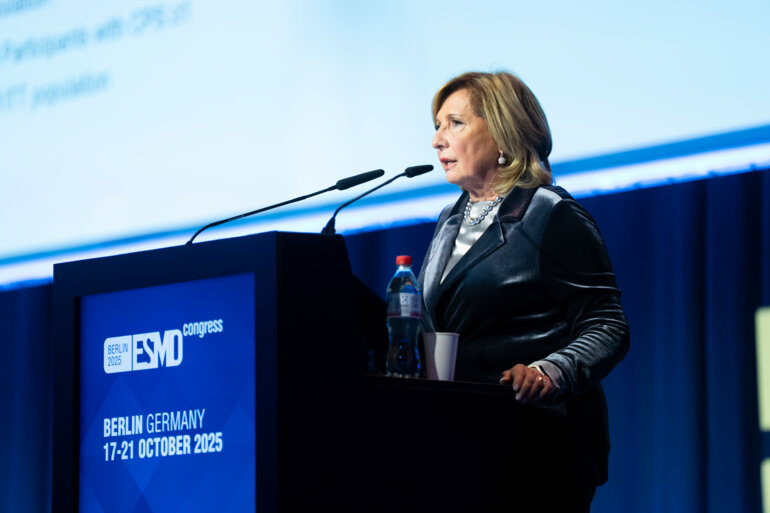The role of PARP inhibitors features in a number of sessions at the ESMO Gynaecological Cancers Congress 2022
There is no doubt that PARP inhibitors have revolutionised the treatment of women with advanced ovarian cancer, both in the recurrent disease setting and, based on trials completed in the last few years, in the first-line setting. Dr Susana Banerjee from the Royal Marsden NHS Foundation Trust, The Institute of Cancer Research, London, UK discusses how to capitalise on the remarkable success story of PARP inhibitors so far.
How have PARP inhibitors changed the management of ovarian cancer?
The SOLO-1 trial changed the standard of care in women with newly diagnosed BRCA-mutated advanced ovarian cancer, demonstrating that not only did olaparib substantially reduce the risk of death or progression compared with placebo (N Engl J Med. 2018;379:2495–2505), it also led to sustained benefits at 5 years in around half of the patients treated (Ann Oncol. 2020;31(Suppl4):S551–S589). Together with subsequent trials of PARP inhibitors in patients regardless of BRCA mutation status – including PRIMA/ENGOT-OV26/GOG-3012 (N Engl J Med. 2019;381:2391–2402) and PAOLA-1 (N Engl J Med. 2019;381:2416–2428) – this has resulted in clinicians having a choice of treatments that can be molecularly tailored to patients, with regulatory approval for olaparib monotherapy in BRCA-mutated ovarian cancer, olaparib plus bevacizumab in patients with homologous recombination deficiency (HRD) and niraparib independent of HRD or BRCA status. With these options, and with the availability of niraparib, rucaparib and olaparib for recurrent, platinum-sensitive disease, we are now able to delay the progression of ovarian cancer and, thereby, the point at which the women will require subsequent therapy. However, mature overall survival data from the first-line studies, which we hope will start to become available next year, will be crucial in refining the role of PARP inhibitors in this setting.
What is the current knowledge on the use of PARP inhibitors in maintenance therapy?
There are several ongoing trials discussed during the Clinical Trial Highlights Special Session at ESMO Gynaecological Cancers Congress 2022 that are looking at novel approaches to first-line PARP inhibitor maintenance therapy. The ATHENA (GOG-3020/ENGOT-ov45) -MONO and -COMBO trial is investigating the use of rucaparib in newly diagnosed, high-grade disease (NCT03522246). The Congress will see the presentation of results from ATHENA-MONO, comparing rucaparib versus placebo. ATHENA-COMBO is investigating the benefits of adding nivolumab to rucaparib. Despite the well-documented benefits of immune checkpoint inhibitors in some cancer types, combination of these agents with chemotherapy has been disappointing in newly diagnosed ovarian cancer (J Clin Oncol. 2021;39:1842–1855). If the combination of PARP inhibitors with immunotherapy is found to be effective, it could open up a whole new avenue of treatment. The other trial being discussed in the Special Session is the China-based PRIME study (NCT03709316), which will provide valuable information on the use of PARP inhibitors across patient ethnicities and the tolerability implications of individualised niraparib dosing.
We should not forget the importance of toxicity management in cancer treatment, including PARP inhibitors, and this topic is being addressed in the Clinical Case Session, ‘Managing the consequences of cancer treatments.’
What are the next steps for PARP inhibitors in ovarian cancer?
PARP inhibitors have improved the outlook for many women with ovarian cancer, but we need to keep being innovative to enable even more patients to benefit from these agents.
One of the most pressing clinical challenges is how to treat patients with resistance to PARP inhibitors. Possibilities include rechallenge with another PARP inhibitor, an approach that is showing encouraging results in the phase III OReO/ENGOT OV-38 trial (Ann Oncol. 2021;32(Suppl5):S1283–S1346), or the use of PARP inhibitors in combination with other DNA damage response inhibitors.
Another focus of attention centres on the better identification of biomarkers for patient selection. A huge effort is currently underway, in the academic setting and beyond, to refine testing for HRD so that we can really distinguish those patients likely to respond to PARP inhibitors from those who are unlikely to derive benefit. This is an area in which the European Network of Gynaecological Oncological Trial groups, in various collaborations, is particularly active.
Finally, it is important for us to remember that it is not all about PARP inhibitors and we must not neglect other ovarian cancers that urgently need treatment options, such as low-grade serous cancers that do not respond well to chemotherapy or PARP inhibitors.
Don't miss:
- Educational Session, Ovarian cancer management in the PARP inhibitor era, 17.06.2022, h. 16:15 – 17:45, Auditorium 1A
- Special Session, Clinical trial highlights, 18.06.2022, h. 10:30 – 12:00, Auditorium 1A
- Clinical Case Session, Managing the consequences of cancer treatments, 18.06.2022, h. 14:15 – 15:45, Auditorium 1A







